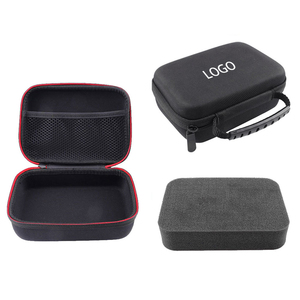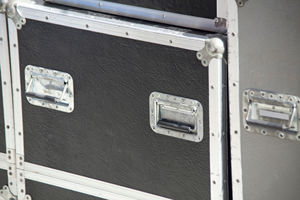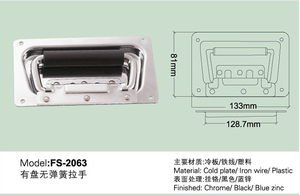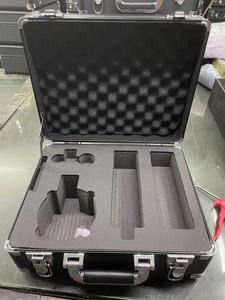
All categories
Featured selections
Trade Assurance
Buyer Central
Help Center
Get the app
Become a supplier

(7986 products available)







































Casing foams have various types according to the structure required for protection purposes. These modifications ensure the security of the equipment.
This alternating foam is attributable to its flexibility in customizing shapes with minimal effort. It contains three layers, each featuring a grid of small interlocking squares. The top and bottom layers are made of medium-density foam, while the center layer is made of firmer foam.
The individual squares can be 'picked and plucked' out as needed, allowing users to create a tailored, cushioned compartment for each item. This modularity makes it suitable for carrying a wide range of tools, gadgets, or instruments that vary in shape and size but often require a similar size of padding for protection.
Convoluted foam, referred to as egg crate foam due to its distinctive topographical design, possesses flexible cushioning attributes. The foam is shaped with alternating peaks and valleys, thus providing robust surface contact to cushion fragile items. Commonly used as a top layer in flight cases, convoluted foam acts as a protective barrier against dropping, shocking, and rapping.
It is extensively utilized in safeguarding audio equipment, cameras, and other sensitive devices. The foam's elasticity and affordability make it a widely adopted option for cushion packaging solutions aimed at prevention against damage during transport and storage.
Unlike pick-and-pluck or convoluted foam, flat foam is a homogeneous piece of foam with no pre-cut shapes or designs. This type of cushioning is frequently applied where uniform protection is required, or when the equipment has a specified predetermined shape. Flat foam is accessible in varying densities and thicknesses.
It is commonly used in applications such as linings for toolboxes, where the stability of precision instruments is crucial. Flight case foam with a flat profile guarantees even cushioning across the entirety of an item, serving to impede movement and minimize the likelihood of impact-related damage during transport.
Flight case foam isemployed in providing custom-made foam inserts for tools. This is an important advancement for organizations working with professional toolkits and machine implement sets. By cushioning items individually in a structured manner, the time required for tool searches and misplacement is greatly diminished in industrial contexts.
This personalized approach in housing tools not only secures them against knocks and bumps but also promotes efficient organization as well as accessibility. The end result is an increase in operational effectiveness within construction, manufacturing, and other technical fields, where promptness and easy availability of the right equipment are fundamental to achieving work objectives.
Packaging materials with foam are usually in great demand for items that are easily breakable. Due to its flexibility, flight case foam can be tailored to the shape of products, thus creating a secure housing through their passage during transport. This feature is critical for industries dealing with sensitive optical systems, precision instruments, or electronic devices that suffer impact.
Including flight case foam in their packaging methodology reduces their probability of incurring losses or claims related to damaged merchandise. Not only does this guarantee the integrity of the product, but it also reinforces the organization’ s credibility with its clients, thereby promoting ecopackaging as a way of boosting financial revenues in a marketplace.
The flight case foams are, therefore, essential to the shipping of musical instruments in such an industry. Irrespective of the value of the instrument going low or high, it deserves the highest possible protection in the case of any eventuality. The music industry protects guitars, pianos, and others with foam, which fits the shape of an instrument like a glove.
With this cushioning, no matter the density of the material, the instruments are fully protected against any possible impact. The foams are extensively used when musicians transport equipment for gigs or in storage, thus enhancing the viability of flight case foam for any investment in musical equipment.
Foam flight cases are still used in medical equipment, especially in the transport of delicate medical devices, tools, and monitoring systems. Such equipment works through embedded technology and still remains fragile. Medical devices are protected by custom-cut foams that align with their shapes to cushion against any impact during transport, which is critical with mobile surgical units or diagnostic imaging tools.
The cases ensure the equipment remains intact after transport, thus complying with safety provisions as well as operational efficiency. Such practice’s growth stresses the apprehension of safety in transit concerning advances in technology and instruments in the medical field.
Density
Flight case foam usually comes with differing densities. Primarily, the density is provided to determine flexibility and hardness. High-density foams provide such features as increased sturdiness, better suited for protecting delicate items.
Water Resistance
Water-resistive feature makes the flight case foam usable in conditions of increased moisture affinity and is an additional characteristic of flight case foam. This helps to mitigate the chances of damage to foams or equipment, commonly in industries, such as music or medical, which require extra moisture protection.
Heat Resistance
Heat resistance characteristics enable foam to keep its strength under conditions of increased temperatures. Such feature is important when the flight case foam is used for storage or shipment in vehicles where extreme heat may cause traditional foam to deform or melt.
Customization Options
Many producers offer specification options for flight case foam, relying on the needs of the widely used concern. Options in thickness, density, and cutout shapes are available to give a snug fit to the products, enhancing their protection.
Preparation of the Flight Case
Before affixing foam, the flight case must be cleaned. Other elements which may be attached to the case should be removed alongside any existing foam or lining, should cleaning be deemed necessary.
Measuring and Cutting Foam
Installation of foam requires proper measurement and cutting of the foam to ensure that it fits snugly inside the case. A sharp blade and a ruler or foam-cutting gadget will be needed. Cut the foam to the required thickness and density, depending on whether it is a pick-and-pluck, convoluted, or flat foam.
Placement of Foam Layers
Items primarily focused on fastening include the bottom layer, which should be a sheet of flat foam when cut to size. Other than the bottom layer, additional layers include a sheet of convoluted or comfort foam, which must be placed on the top layer of flat foam. This is to provide padding consist of fluctuation to cushion against fault.
Inserting Custom Cutouts
If the case calls for personalized cutouts, after measuring and cutting the appropriate pieces of foam, these should then be inserted into the case. Ensure every piece aligns with the proper area for maximum protection.
Closure and Testing Fit
The case should be closed securely after placing all foam inserts. Give it a slight shake and examine the snug fit of each item within its designated compartment. Make adjustments if necessary to ensure none of the items move when the case is jostled.
Maintenance Tips
Maintenance of flight case foam involves constant checks for signs of wear and tear. Assessing foam for parts that have been compressed beyond recovery or containing holes is practice number one. Clean foams using a damp cloth but dry them well before further placement to avoid moisture buildup.
Repairing Damage Foam
This could be the case with foam possessing minor rips or punctures. Patchwork repair items can be used to cover the affected areas. Alternatively, certain types of repair foams, when embedded into the spaces, will provide the necessary cushioning. Severely worn or damaged pieces may be cut out and replaced with new ones.
Extending Foam Life
Using flight cases in normal temperatures and avoiding extreme heat or cold environments helps extend the lifespan of flight case foam. Also, minimizing contact with sharp objects and cleaning substances of foreign particles that could compromise the foam integrity.
Foam density is a very significant factor in relation to the protective capability of flight case foam. Quality foam, which has supposedly huge density, comes with more support and cushioning. This lessens the effect on any equipment inside the case, in particular, fragile instruments. Low-density foam can compress when under heavy impact, leading to an unacceptance or damage of contained valuables.
To begin with, medical instruments, electric acoustic instruments, or gauntlets, it is important to use high-density foam to ensure the material is well protected from any form of shock and impact. Furthermore, quality monitoring of foam is important because degraded or old foam may lead to catastrophic destruction.
Another critical feature of safety related to flight case foam is the flame retardancy feature of foam. Generally, flight cases are utilized in many such instances, which do not rule out the heat exposure possibility. Consequently, it is important that the foam used is retardant to flames. This will help contain its noncombustibility, allowing the flames and the resultant combustion of such enclosed items.
In this regard, a flame-retardant flight case foam insert is essential for protection against heat trap cases, like turnover in vehicles, transport by planes, or storage in heat-prone areas. Applying such foam enhances security and decreases the likelihood of ever experiencing hazardous situations tied to open fire.
Many manufacturers usually have flight case foams with necessary safety standards test reports, including those related to density and flame retardancy of the foam. Check certifications such as CARB compliance ca signify the foam has low off-gassing potential, which is harmful to health.
Choose products with such certifications to use in medical areas where air quality significance is vital. Another certification is related to VOCs and phthalates; their absence in foam indicates safer environment tissue-friendly products.
When it comes to the protection of delicate and expensive equipment, it is recommended to use only quality-grade flight case foams. Those that have handily attachment to cases have premium cushioning properties and provide the largest possible protection against the most rigorous environment.
Foam graded for professional use generally passes physical tests for durability, density, and ecological values. These make such viable options for industries like medicine, music, and video production, as mentioned earlier, that require foam to do its job properly for the long term.
A1: Flight case foams come in differing varieties, such as pick-and-pluck foam, convoluted foam, and flat foam. They are usually made of polyurethane, renowned for its durability, elasticity, and premium shock-absorbing capabilities.
A2: Indeed! A distinct feature of flight case foam is its ability to be customized to fit unique shapes. Such customization allows maximum security for equipment as the foam will take the shape of items, denying spaces where movement can generate possible damage.
A3: The required thickness relies on the fragility of the item in question and how securely it needs to be packed. A more delicate item would do better with thicker foam to ensure more cushioning. For sturdy items, thinner foam of up to 5 to 10 mm is adequate.
A4: Flight case foam provides protection via two ways: cushioning and support. During impact, the foam absorbs shock and distributes it evenly across the item. This way, no one section bears the full force of the impact, which could lead to damage.
A5: Most brands nowadays tend to manufacture foam with environmental concerns in mind. They make flight case foams that are recyclable or produced containing low-density organic compounds (LDCs).